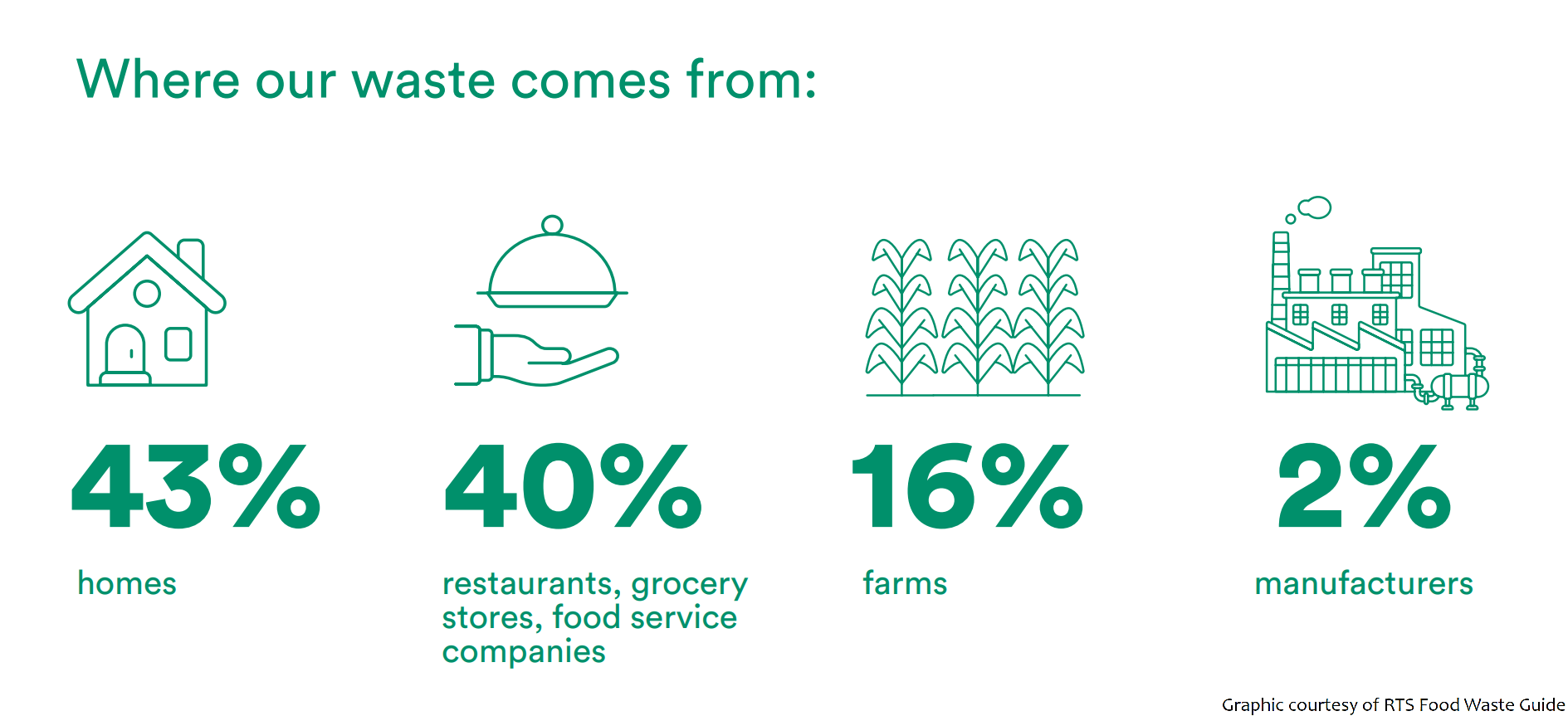Food Waste Education Outreach Program
Food truly is treasure in more ways than you can imagine!
We’re working to reduce food waste in Rochester and we want you to join us. With easy tips and actions to take, you can help reduce food waste in your home or at the office. Quite often, we cook or buy too much food and it ends up being thrown out.
This site will provide tips, key facts, resources, and simple ways you can help to minimize the amount of food we waste each year in our city. When we each take small action steps towards repurposing our food and saving what we can, we increase our food’s life cycle and save money, lives, and our planet!

Why is Reducing Food Waste Important?

Big Picture
- 31% of available food at the retail and consumer level went uneaten or 133 billion pounds, representing $162 billion or 141 trillion calories.
- Up to 40% of all food produced goes uneaten in the US. That is equivalent to $165 billion each year and 20lbs of food per person per month.

Cost Impact
- The average American family of 4 spends $1,600 a year on food that goes uneaten.
- Americans spent more annually on wasted food than on vehicle gasoline ($1,250); apparel ($1,207); household heating and electricity ($1,149); property taxes ($1,046); and household maintenance, repairs, and insurance ($936) for the average single-person household in 2017.

Hunger Impact
- Reducing food loss and waste by just 15% could feed more than 25 million people a year.

Wasted Resources
- Getting food to our table consumes 10% of total US energy, 50% of US land, and 80% of US freshwater.
- Food that is never eaten in the US consumes 21% of all freshwater, 18% of cropland, 19% of all fertilizer, and 21% of landfill volume.
- Food waste contributes to the wasting of fresh water. Every pound of beef thrown out sends to the landfill the equivalent amount of fresh water as 370 minutes of the shower being run — 104 minutes for every pound of chicken, 5 min for every tomato, 42 min for every pound of bananas, and 122 min for every pound of cheese.

Where Does Food Waste Occur?
- 85% of food waste occurs downstream in consumer-facing businesses and homes.
- 50% of seafood, 48% of vegetables, 38% of grains, 22% of meat, and 20% of milk gets tossed.
Environmental Impacts
- In the US alone, the production of lost or wasted food generates the equivalent of 37 million cars’ worth of GHG emissions.
- In a landfill, food waste creates methane, a greenhouse gas 28 times more potent than CO2.
- Composting food waste avoids the production of greenhouse gas emissions in a landfill and actually stores and restores carbon in the soil.
- According to the US EPAs WARM model, 1 ton of food waste generates 1190 lbs. of CO2e GHG emission in a landfill while composting can remove 397 lbs. CO2e/ton.
- Food waste globally is responsible for 3.3 gigatons of CO2e annually which if regarded as a country would be the third-largest emitting country after the US and China.

Landfill Impacts
- Food waste is the single largest component taking up space inside US landfills (21%) and accounts for 18% of all waste in NYS.

Local
- Commercial and residential food waste is estimated to make up 30% of Rochester Municipal Food Waste or 29,812 tons of food waste (LaBella et al., 2020) or about 0.8 lbs. per person per day, yet one in four Rochesterians is food insecure (Gunderson et al., 2018, based upon 203,265 population Census.gov quick facts).
- The climate impact of landfilling 29,812 tons of food waste is equivalent to 16 thousand flights from Rochester to Paris (540kgCO2e/ton FW (WARM EPA)) - 1MT CO2e /flight one way co2.myclimate.org/en/flight_calculators.
- If just 50% of the City of Rochester’s food waste were never purchased in the first place (source reduced), that would be equivalent to taking 11,860 cars off the road per year. (14,906ton/year) * 3.66MTgCO2/ton= 54,556MTkgCO2e/year typical car 4.6MTCO2/yr (EPA)
- Effective January 1, 2022, the NYS Food Donation and Food Scrap Recycling Act will require businesses and institutions that generate an annual average of two tons of wasted food per week or more to not only donate excess edible food but also recycle all remaining food scraps if they are within 25 miles of an organics recycler (composting facility, anaerobic digester, etc.).

Tips and Actions
Need help getting started? Our food waste reduction starter kit will help you take your first steps on your journey to reducing food waste in your home!
- Make a pledge to help reduce food waste and hang on your refrigerator. Download and print a pledge form here.
- Use different sauces, dips, and spices to keep meals interesting from day to day.
- Use fruit and vegetables that are about to go bad in healthy smoothies.
- Use smaller plates and portions and encourage asking for seconds.
- Shop your refrigerator! Before you buy something new at the grocery store, take a look at what’s in your fridge and pantry, and get creative with your next meal.
- Eating chicken, rice, and green beans for the third time this week? Essential spices (cumin, garlic powder, chili powder) and sauces like soy sauce, barbecue, ranch, and peanut sauce can bring new life to any leftovers!
- People tend to like things they helped make, and children are no different. Involve your kids in cooking! Give them choices when possible, and allow them to serve themselves in the portions they want — within reason.
Savethefood.com - This NRDC website has a clean design with all the essential food waste information in an easy to find format.
DEC.NY.gov - This Department of Environmental Conservation website has tips on how to reduce food waste, shopping and prepping info, and wide range of resources.
EPA.gov - This Environmental Protection Agency site focuses on tips to reduce food waste and a toolkit resource for your home and your community.
Lovefoodhatewaste.com - The UK Wrap website is a very comprehensive site and a great source of out of the box ideas. However, it is a little hard to navigate.
Findfoodsupport.withgoogle.com - This locator tool you can use to find your nearest food bank, food pantry or school lunch program pickup site. The site also has national and state eligibility requirements, as well as information about how to apply for SNAP benefits.
Ivaluefood.com - This Sustainable America site is really nice with tons of information, a Waste Quiz (similar to behaviors survey but in a fun way), an online FTGTW challenge, recipes, a refrigerator guide, tips for youth, ideas for ‘Leftover night' (i.e. - salvage party), and more.
Loveyourfoodny.org - This is a nicely designed site. Eat. Share. Compost the Rest. Love Your Food NY is an initiative to raise awareness about reducing food waste in the Town of Mamaroneck, Village of Mamaroneck, and Village of Larchmont.
Westcoastclimateforum.com - This site focuses on Food Too Good To Waste with an overview and links to participating Program sites and reports.
King County Food-to-good-to-waste -This site overviews a social enterprise including collaborative hands-on programs, culinary job-training with a trauma-informed curriculum, catering, online resources, consulting, and recovery services. They provide strategies that benefit local communities, save money, and alleviate strain on the environment. Programs increase awareness and action around food waste reduction and create jobs in the food recovery sector. Just a small section of the website has tips.
Scrapfoodwaste.org - This State of Vermont site is a good source for a few high-level and clearly communicated tips with a small compost focus for the rest of the site.
FCgov.com - The Fort Collins, CO site includes a challenge worksheet and nice slogans. Information and campaigns include, “I'm Not Dead Yet” (revive food), “Bring Out Your Dead” (recycling — animal feed, waste cooking oil, compost, garbage disposal), and a link to meal planning apps.
Foodprint.org - What are expiration dates and what do they mean? This confusing topic is straightened out by this Foodprint Blog: Should You Follow Expiration Dates and Sell-By Dates. The more we know about how our food goes bad, the better and faster we can use it up before it goes to waste!
- How can your different ingredients do double duty? If you’re thinking of making tacos one night, what other meal can you make with those tortillas?
- To preserve freshness and nutrition, use perishables like seafood and meat earlier in the week, and save staples like pasta, dairy, and eggs to eat later in the week. Additionally, some heartier greens, like kale and chard, will stay fresher longer than others.
- Store your fruits and veggies in the fridge — or on the counter — based on their specific needs for staying fresh!
- Create an “Eat me First” box to highlight the fruits and vegetables or other food that can be prioritized for meal preparations.
- Check out some of our recipe resources and make a dish.
- Links to leftover recipe sources
- Scraps - Recipe Results - Save The Food
- More recipe resources at the bottom of this page!
- Choose fresh foods that will freeze (spinach, broccoli, Brussels sprouts, beans, peas, etc.).
- Wilted? A quick soak in ice water for 5 to 10 minutes is often enough to reinvigorate wilted veggies. Bendy carrots will straighten right up, lettuce will crisp, and limp broccoli will find its strength again.
- When ordering take-out, only order what you can finish by asking about portion sizes and be aware of side dishes included with entrees. Or, plan on ordering enough to keep leftovers for your next meal.
- Frozen foods last longer. Try using frozen vegetables and buy smaller amounts of fresh vegetables — this way, you won’t end up with veggie-less meals by the end of your week.
- Whether you have a vegetable garden at home or have some leftovers from your most recent shopping trip, share your abundance with neighbors! Post in the NextDoor app or in your neighborhood Facebook Group to prevent food waste in our community.
- City of Rochester Food is Treasure Program Guide (PDF)
- Easy Tips for Reducing Food Waste at Home (P2I PDF)
- Food Waste Essentials eBook (RIT P2I)
- Organic Resource Locator (RIT P2I)
- The Guestimator Food Meal Prep Tool (savethefood.com)
- Interactive Storage Guide (savethefood.com)
- EPA Implementation Guide and Toolkit
- Seven Online Meal & Menu Planning Tools | Kitchn (thekitchn.com)
- Eureka food Storage Guide A-Z (eurekarecycling.org)
- EPA- date labeling fact sheet (USDA.gov)
- Create a menu and keep an inventory of ingredients.
- Don’t start from scratch! Successful meal planning doesn’t mean hours spent with a cookbook. Start with family favorites or your go-to meals. Repeat them every week or two.
- Once you’ve gotten the hang of meal planning, throw in a new recipe.
- Create and keep a recipe book. That way, when you’re looking to put together a meal plan, you can flip quickly through it for ideas.
- Start with building blocks for your week. Pick two types of protein, one or two grains, and a vegetable medley to make at the beginning of the week (or every other night) and incorporate them into different meals throughout the week.
- Learn about portion planning. Use this simple tool to determine how much of a meal you need to cook, depending on your household size. This tool also works great when friends or family are visiting.
- Guestimator - Save The Food [savethefood.com]
- Make a plan each week for what meals you’re going to cook. Utilize a shopping list to ensure that you buy all the ingredients you need and the correct portions. Download a shopping list here.
- Start with family favorites or your go-to meals. Repeat them every week or two. Once you’ve gotten the hang of meal planning, throw in a new recipe.
- When you get home from the store, wash dry, chop, dice, slice, and place all your fresh food items in clear storage containers for snacks and easy cooking.
- Build and maintain your own vermi-composter (composting with worms).
- Vermicomposting instructions [EPA.gov]
- Learn how to prepare healthy food to make it taste appealing to all members of the household.
- Save time by batch cooking meals that can be stored in the fridge (for a day or two) or in the freezer for later in the week. For example, bake and freeze chicken breasts that can be defrosted and used later in salads, pasta, sandwiches, or soup.
- If you’re ambitious, you can revive kitchen scraps. Onion and green onion bottoms, celery, and lettuce cores can be replanted to generate more of themselves. Just throw them in a cup with some water, once rooted, put into a small bowl with soil.
- Tired of leftovers? Looking for a little inspiration or creativity to recreate your meals? Check out these fun, family-friendly recipes to turn your leftovers into creative new meals that everyone will enjoy!
- Save The Food Recipes – This site offers featured recipes, cooking with food scraps, and saving food past its prime. They also have vegan, vegetarian, dairy-free and gluten-free recipes.
- The Scramble Prep and Recipe Resource – This site offers resources and learning tools from cooking fundamentals and kitchen organization to their how-to library. They also have seasonal, special diet, and kid friendly recipes.
- King County Recipe Box - Full of recipes that can help you save time, waste less and stretch your grocery budget.
- Stop Food Waste Leftovers Recipe Book – This recipe booklet by DSM is created in the spirit of Stop Food Waste Day on 29 April, promoting worldwide awareness and action on the importance of food and good nutrition. Food and nutrition is fundamental to achieving many of the Sustainable Development Goals.
- 25 Easy SmoothieRecipes (allrecipes.com) – This site has 25 recipes for smoothies with three ingredients or less.
- Thirteen Easy Sauces! (hilahcooking.com) - Easy sauce recipes for any meal or occasion.
- Ikea’s Scraps Book - A cookbook dedicated to cooking with the little things we usually throw away. Featuring 50 recipes created in collaboration with chefs across North America and waste-saving tips, all designed to help you live a little more sustainably in your kitchen.
- Food Waste Free Recipes - Morton Salt – Check out these 43 food waste free recipes that include ingredients you might normally toss.
Composting
Composting is the final stage before landfilling in the EPA's Food Recovery Hierarchy which is posted under the Food Waste Reduction Tools section above.
Composting is not only a great way to create nutrient rich soil but it also reduces green house gas emissions while sequestering carbon in the land. To learn more about the City's Roc City Compost Pilot Program click here.
To learn more about the City's Food Waste Reduction, Donation and Organics Recycling Program click here.

Funding Acknowledgement
This program has been partially funded by the Environmental Protection Fund as administered by the New York State Department of Environmental Conservation.






